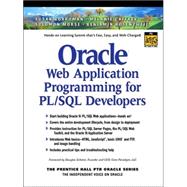
SUSAN BOARDMAN, Lead Software Engineer for IntraSphere Technologies, specializes in using PL/SQL to build intranet Web applications. She has extensive experience with retail systems, back-end processing, and university applications.
SOLOMON MORSE, Senior Consultant for Net Quotient Consulting Group in New York City, specializes in designing and developing database-integrated e-business Web applications. He has developed Web applications for cutting-edge e-journals as well as for Fortune 500 companies.
MELANIE CAFFREY is an Oracle consultant in New York City, providing front-end and back-end Oracle solutions to numerous clients. She is co-author of the Oracle DBA Interactive Workbook and Oracle Database Administration: The Complete Video Course.
BENJAMIN ROSENZWEIG is an Integration Specialist at IQ Financial Systems. Prior to that he was a principal consultant for 3 1/2 years at Oracle Corporation in the Custom Development Department. He has a wide range of computer experience from creating an electronic Tibetan-English Dictionary in Kathmandu, Nepal, to supporting presentations centers at Goldman Sachs and managing a trading system at TIAA-CREF.
The authors are all members of the faculty at Columbia University School of Continuing Education.
I. INTRODUCTION.
1. Introduction to Oracle Web Applications.II. CREATING THE APPLICATION.
III. TAPAS.
The New copy of this book will include any supplemental materials advertised. Please check the title of the book to determine if it should include any access cards, study guides, lab manuals, CDs, etc.
The Used, Rental and eBook copies of this book are not guaranteed to include any supplemental materials. Typically, only the book itself is included. This is true even if the title states it includes any access cards, study guides, lab manuals, CDs, etc.